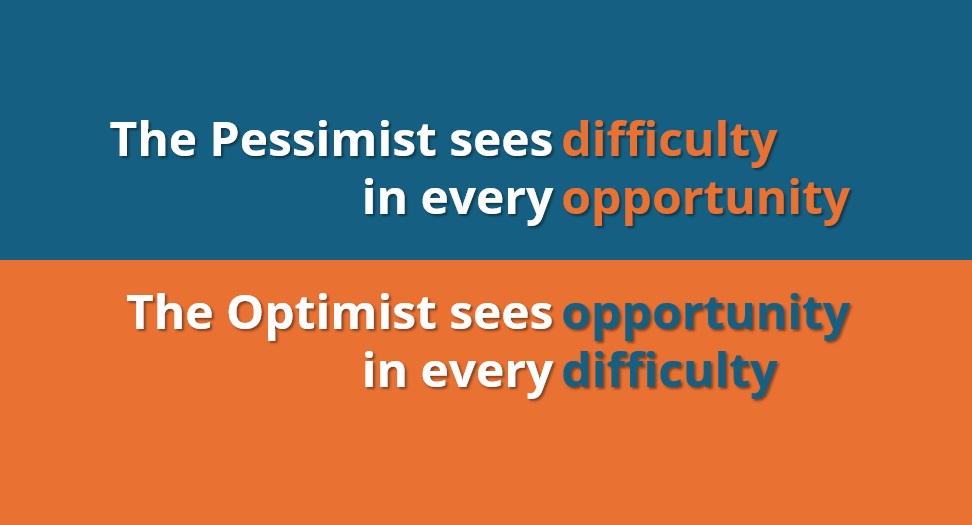Reframing is a creative technique used to shift an initial or existing mindset to be able to look at a situation, problem or idea from a different perspective.
If that definition flies over your head, let me reframe it.
For example, when trying to solve a problem, we are often blinded by our own perspective.
We might know too much about it.
It’s so much easier to suggest solutions when you don’t know too much about the problem. Malcolm Forbes, publisher of Forbes magazine
We use too much of our own background and history.
The more you reason, the less you create. Raymond Chandler, novelist and screenwriter
We might assumptions.
Your assumptions are your windows on the world. Scrub them off every once in a while, or the light won’t come in. Alan Alda, actor
We was blocked by negativity or a lack of self-confidence.
A pessimist sees difficulty in every opportunity. The optimist sees opportunity in every difficulty. Winston Churchill, former Prime Minister of the United Kingdom
Improving Your Creativity By Reframing the Problem
The beauty of reframing as a simple creative technique is how quick and simple it is.
Start with whatever you believe is either the important goal you want to achieve or the essential problem you want to get rid of.
Then, change the frame.
By finding new words, visuals, behaviours, you can’t help but change what you think, what you see or how you behave.
At the same time, it gets rid of old news, antiquated information, assumptions, bias and negativity.
So how do you reframe, exactly?
Here’s some suggestionsfor using reframing as a brainstorm or creative technique.
Ask someone else to look at it. What do they see? Listen, don’t judge. If you don’t like what they say, ask someone else. (If you don’t like any other response: two points. Maybe there isn’t another POV. Or, maybe you’re the problem.)
Ask someone who knows nothing about the problem. Talk to a kid. Check in with your mother or grandmother. Find someone who works in an entirely different role in your organisation.
Talk to the person who has the problem. Speak to your customer. Your supervisor.
Ask someone in an entirely different profession or occupation. (See New Point of View as a brainstorm exercise.)
Talk to anyone who professionally, often on purpose, takes a different point of view. Talk to a journalist, blogger, lawyer. Even your mother would do.
Reposition yourself. Photography class instructors talk about how a person should look at their shot from different perspectives. Do the same with a brainstorm. Change locations. Switch up the people. Swap out what you bring in, either as samples or creative techniques for reframing. Change the project, product, service etc. by replacing it with a metaphor, including using images as metaphors for creative thinking.
Literally change it. Turn it upside-down. Look at it backwards. (Or from the end or outcome, not from the beginning.) Make it smaller. Larger. Remove or add an attribute. (This one is not always useful, but oh boy, it can be fun.)
Try it for yourself. Did it work as you thought it would? How should it have worked? What can you do to improve it or make it more useful?
Try crowdsourcing. Here’s a good introduction: 10 Commandments of Effective Crowdsourcing.
Some real-life examples
Here are some real-life examples from just one edition of a recent The Sunday New York Times. (The articles may require a subscription.) If you can’t access, pick up any newspaper, real or digital, and go through looking for examples of other organisations using reframing as a business or marketing device.
Foods with Benefits, or So They Say FMCGs and similar looking at ways to deliver functional benefits in existing food products.
‘Sex on Wheels’? Now It’s Room for Groceries Too Ferrari moving beyond vroom for thrills to room for hauling stuff around on the weekends.
Innovation, Gliding Across the Generations How two men re-purposed their grandfather’s invention for a different spot in 2011.
Behind The Greening of Walmart Convincing Wal-Mart to embrace sustainability simply by repositioning a conversation from hugging a tree to eliminating waste.
Even in the photo essay Seeing Beauty In The Rust Belt, Alyssha Csük used the leave-behinds from Bethlehem’s economic disuse as stimulation for things of beauty.
Or, maybe you just need to get away from it
One of the best ways to re-position something is to take a vacation from it. Either give it to someone else to brainstorm, or if that’s not possible, then put some distance between it and you.
I was helping my friend Paul brainstorm ideas last week long-distance. He’d been struggling with the problem for 3-4 days, obsessing over it. Obsession and creativity are fast friends, but at the same time, as my Grandma Eklund said, everything in moderation. (Hmm. Can you be moderately obsessive?)
Anyway, Paul needed to give himself a break by doing something else. That’s the good thing about your brain: it’s like a beagle on a sock when it comes to creativity. Your brain will continue to think of new solutions/ideas while you’re doing something else. If you ask me, it’s the perfect way to multi-task.
How else have you used reframing as a technique to improve your creativity? Please add your thoughts and comments below.



No comment yet, add your voice below!